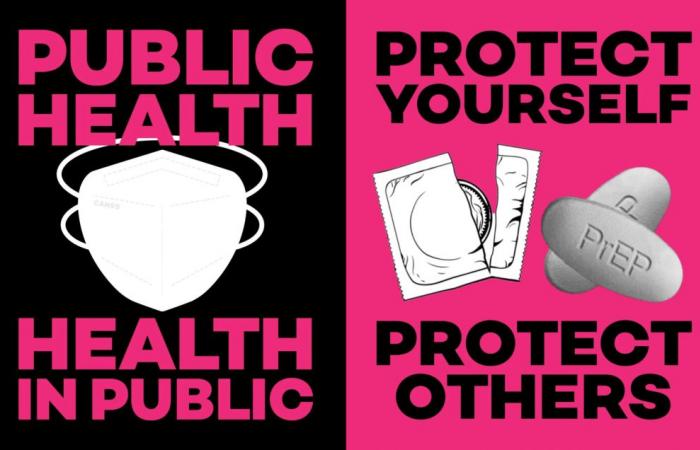In the world of those who are aware of the dangers of Covid, it is not uncommon to read or hear comparisons between Covid and AIDS. They are based on the common points between the Sars viruses-COV-2 and you HIVtheir health effects, the characteristics of the two epidemics and the political struggles that they gave rise to. Comparisons are stimulating when they outline perspectives of struggle. They are enlightening for integrating the social and political dimensions of epidemics or for understanding why viral diseases always hit people already marginalized and discriminated harder. But, as attractive as they may seem, these comparisons are often simplistic and obscure the differences allowing a better understanding of the two epidemics and the issues that arise from them.
Epidemiologically, the viruses causing AIDS and Covid have more in common than we would like to believe. In particular, they are both systemic viruses (i.e. affecting all organ systems), which attack the immune system of infected people. In detail, the two viruses share the same trigger for the destruction of lymphocytes (the white blood cells which are used for the body’s defense), as we have seen in 72% of patients affected by severe forms of Covid. This similarity partly explains the long forms of the disease: lymphocytes continue to malfunction for 2 years after contamination. Finally, studies also suggest that SARS-CoV-2 causes cell apoptosis (programmed cell death) of certain T lymphocytes in the immune system.
In the AIDS epidemic as in that of Covid, early detection constitutes an essential tool to prevent transmission and allow rapid treatment (post-exposure treatment to be taken within 48 hours and antiretroviral from diagnosis for AIDS, antivirals to be taken within 5 days for Covid). The absence of prevention and treatment can lead to increasing isolation (loss of employment and social life) and death in both diseases. Diseases linked to HIV caused another 2.6 million deaths from 2020 to 2023 worldwide, the majority of them in Africa. In France, the people who continue to die from AIDS are mainly heterosexual women from sub-Saharan Africa aged 60 on average. Over the same period, Covid caused 35 million deaths, which includes direct deaths due to infection as well as deaths resulting from long Covid, in particular that in the form of myalgic encephalomyelitis: the United States has officially recognized 5 000 deaths from long Covid, a figure that is largely underestimated but which has the merit of recognizing that in fact, we also die from the delayed effects of Covid. There too, old, disabled, racialized people, LGBTpoor, neuroatypical, have paid the heaviest price for the pandemic.
In terms of political and social management of the two diseases, the categorization of certain segments of the population as vulnerable (gay men and injecting drug users in the case of HIVthe elderly and immunocompromised people in the case of Sars-COV-2) has in turn created a false feeling of invulnerability in the rest of the population. The feeling of invincibility of heterosexuals vis-à-vis AIDS or people without “ comorbidities » with regard to Covid have contributed to the denial – largely encouraged by Western governments – of these diseases, and to the refusal of prevention. The hood in its time provoked a similar outcry, if not stronger, than the mask. The ban on advertising for its use was only lifted in 1986, after 10 years of long militant work of education and acceptance. In the case of AIDS and Covid, the health opinion is made by those who dominate: homophobes and serophobes in one case, covid-denialists and validists in the other. This favored, in both epidemics, the dissemination of racist theories on the origin of viruses (negrophobic for AIDS, sinophobic for Covid) and the proliferation of supposed alternative treatments on the part of conspiracy and pseudo-scientific circles.
Reluctance to reduce risks (RDR) in the case of Covid also takes up fragments of speech that fizzle out: cis men who cannot get an erection with a condom cannot breathe with a mask either. As for the accessibility of syringes, the question remains a real problem which continues to come up against the wall of toxicophobia. More broadly, the almost general indifference to the fate of others reflects a eugenics of the privileged towards fragile, vulnerable populations, considered dispensable, and whose health or survival merit no effort, no provision. . In both cases, populations are expected to “ supernumeraries » that they stop living: ultimately, transpedegouines were asked to stop being so, while the elderly, immunocompromised or disabled people are today asked to stop leaving their homes. In response to this generalized abandonment, it is isolated activists, including those in the struggle camp, who self-organize prevention and produce information based on scientific knowledge and advances in treatment. Few in number, these activists who shout in the desert, pass for fanatics – before, it is proven for AIDS and expected for Covid, that their demands become foundations of public health.
However, there is no shortage of differences between the two epidemics. They are fundamental to note so as not to make the specificities of illnesses and struggles invisible. In the first place, the modes of transmission have nothing to do with each other. Fighting against an epidemic that is transmitted through shared air is not the same as fighting against a sexually transmitted disease, in utero and by injection/transfusion. In the first, the risk is constantly present in all everyday spaces, which requires building collective solutions (ensuring good air quality everywhere) and weakens the only individual prevention measures (the mask worn unilaterally). In the second, on the contrary, if the state organization of prevention also constitutes a fundamental basis, personal tools such as the condom, single-use syringes or Prep prove essential.
The perception of the disease by the general public is also not the same in that homophobia completely structures the perception of AIDS, of the sick, and the consequences on the loved ones of people who die. The fight against homophobia is inseparable from the fight against AIDS. It was carried out during the 1980s and 1990s by a community LGBT and it continued outside of health issues with the fights for PACS then marriage. More generally, systems of oppression are not interchangeable and homophobia and drug addiction are not oppressions identical to ableism and ageism. If both epidemics strike people in socially vulnerable situations, these oppressions do not carry the same moral charge. The struggle of HIV/AIDS in particular was able to develop because it was taken care of by gay and lesbian groups already sharing a political marginality and habits of collective organization when they were hit hard by the epidemic (although it there is historically no gay community in this regard). This facilitated both the politicization of AIDS and community care actions within the community. LGBT. At this stage, no political community has taken charge of Covid, the associations of sick and disabled people mostly refusing to politicize themselves as much as to take charge of the situation – the politicization of the epidemic is slipping.






